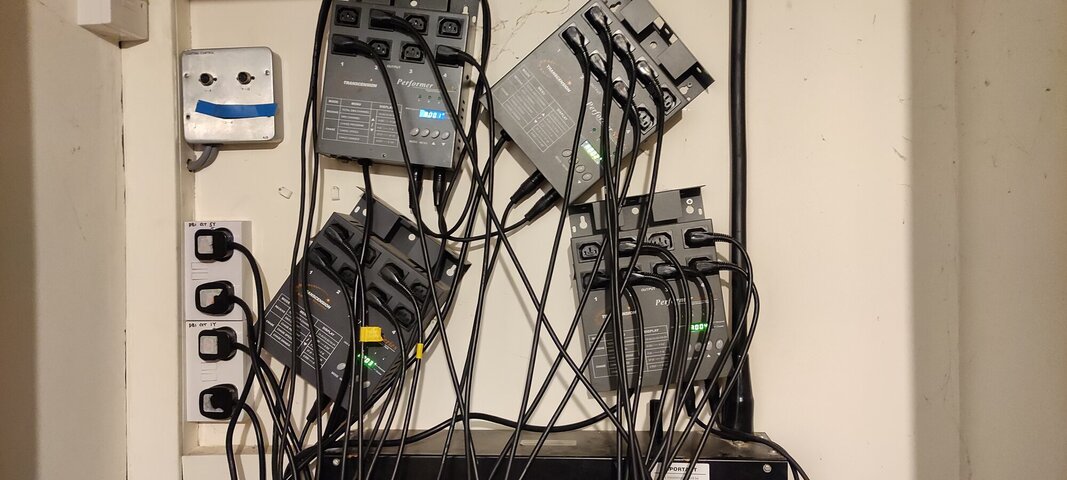We've been asked to help a School re-connect the lighting in their Theatre and we're struggling to address the dimmer packs correctly. They've lost their previous tech guy and all the lights were disconnected for testing, so we've been working pretty much from scratch to get it all back up and running.
I don't have much experience (local drama group) but they really need the help for an upcoming Peter Pan performance next month. I'll try and explain the problem as best I can and have taken some pictures in case that helps.
The setup is as follows:-
Showtec Showmaster 48 lighting desk
4x Trancension DDP-405 dimmer packs
14x Pulse Stagepar 108
6x Eurolite par 64
Waterfall effect light
(Downstairs:-
Star curtain
Fogger
'Beamz' wash light)
I'm used to a console where I can manually patch lights (Z88 Jester) and have no experience with dimmer packs.
We first tried assigning the dimmer packs 4 channels each, then 8 and 16, but I'm unsure if this is the correct approach or if I need to take the fixtures themselves into account. We did finally get some control over the six parcans when using 4 channels per pack but the LEDs are eluding me and I can only control one of them without 'binding' them to the Parcans channel.
I'm pretty sure I've got the addresses wrong and some functions are overlapping.
If anyone can tell me what approach I should be taking to determine each address on the dimmer packs I would be hugely indebted. Also, how would you go about organising the lights across the packs? I was thinking along the lines of having the Parcans split across 2 dimmer packs so we could have individual control, and the remaining 2 packs control the LEDs? If that's even possible.
Here is a picture of the packs themselves. The cables are numbered out of view. (Ignore the addresses here as I was just trying 1,2,3,4 out of desperation!)
(There is also a note stuck to the Showmaster saying about leaving channels 4, 8 and 12 up. I'm assuming these were the previous LED control channels?)

I have a few more pictures of the setup and space if needed.
I realise I'm a bit out of my depth here but I'm keen to learn and really want to help the school. Their drama department has really suffered lately and the kids are losing interest in the Theatre.
Thanks very much in advance if any of you can help me understand all this.
I don't have much experience (local drama group) but they really need the help for an upcoming Peter Pan performance next month. I'll try and explain the problem as best I can and have taken some pictures in case that helps.
The setup is as follows:-
Showtec Showmaster 48 lighting desk
4x Trancension DDP-405 dimmer packs
14x Pulse Stagepar 108
6x Eurolite par 64
Waterfall effect light
(Downstairs:-
Star curtain
Fogger
'Beamz' wash light)
I'm used to a console where I can manually patch lights (Z88 Jester) and have no experience with dimmer packs.
We first tried assigning the dimmer packs 4 channels each, then 8 and 16, but I'm unsure if this is the correct approach or if I need to take the fixtures themselves into account. We did finally get some control over the six parcans when using 4 channels per pack but the LEDs are eluding me and I can only control one of them without 'binding' them to the Parcans channel.
I'm pretty sure I've got the addresses wrong and some functions are overlapping.
If anyone can tell me what approach I should be taking to determine each address on the dimmer packs I would be hugely indebted. Also, how would you go about organising the lights across the packs? I was thinking along the lines of having the Parcans split across 2 dimmer packs so we could have individual control, and the remaining 2 packs control the LEDs? If that's even possible.
Here is a picture of the packs themselves. The cables are numbered out of view. (Ignore the addresses here as I was just trying 1,2,3,4 out of desperation!)
(There is also a note stuck to the Showmaster saying about leaving channels 4, 8 and 12 up. I'm assuming these were the previous LED control channels?)
I have a few more pictures of the setup and space if needed.
I realise I'm a bit out of my depth here but I'm keen to learn and really want to help the school. Their drama department has really suffered lately and the kids are losing interest in the Theatre.
Thanks very much in advance if any of you can help me understand all this.




